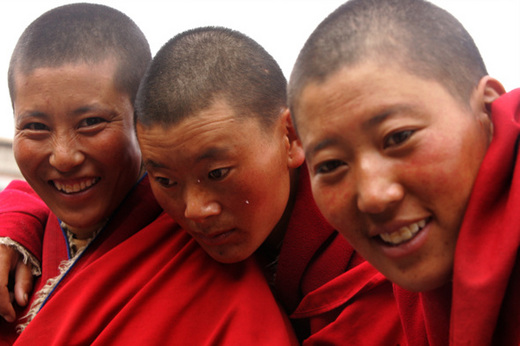 |
After centuries of isolation, traditional way of life sees rapid change
Railroads, symbols of commercialization and modernization, connect some of the most remote corners of the world. On July 1, the Qingzang Railway began operations, opening up remote Tibet to China and the world. Surrounded by snow-capped mountains and under a canopy of blue sky, Tibet now stands at the crossroads of independent modernization and full-fledged Sinicization, after having maintained its unique religion and culture for centuries. From September 11-17, Hankyoreh correspondent Lee Sang-ju took a look at today’s Tibet while riding the Qingzang Railway. To foreigners, Tibet is viewed as a spiritual land. However, over the last four to five years, the new urban areas of Tibet have seen rapid change. Youths in the sacred city of Lhasa often celebrate Western holidays, knowing more about Valentine’s Day and Christmas than they do of the traditional celebrations of their own culture. Every night, they crowd the discotheques and karaoke rooms of Lhasa, and it is projected that the opening of the Qingzang Railway will only increase the speed of this area’s transformation. Since the opening of the railroad, such multinational chains as McDonalds, KFC, and Starbucks have been racing to penetrate the Lhasa market. The change in Tibet is visible even among the Buddhist monks, who make up a majority of the population. Piety is not apparent upon first sight of the sunglasses-donning, cell-phone-armed monks who window shop in their shiny new shoes. Many of them brazenly ask tourists for money upon making their acquaintance. After taking pictures with travelers, they reach out their hands expectantly. Tibet carries on the tradition of the Rinpoche, or Living Buddha. These Living Buddhas number more than 160, and upon death, a reincarnation is found in a young child. The Living Buddhas are the spiritual backbone of Tibet. However, recent years have seen mounting criticism regarding the corrupt practices of some such monks.One monk I met on September 15 at Lhasa’s Jokhang Monastry said, "If a Living Buddha steps out politically and gathers a great fortune, they receive the angry gaze of their believers." One of the vice-chairman of the Chinese People’s Political Consultative Conference is a prime example. A Living Buddha, he is known as the richest man in Tibet. Another of them is a vice-chairman on the same political conference, and third, there is one who serves as a vice-chairman in the Tibetan local government. "Many believers offer donations to the Living Buddhas, so it is quite easy for them to amass a fortune," said Venerable Lee. "The wealth of the Living Buddhas is a strong example of the corruption of Tibetan Buddhism." While the opening of the Qingzang Railway is forcing upheaval upon these distant regions, there is much to be said in support of the claim that Tibetan Buddhism will not easily crumble. The strong faith seen among the waves of praying believers in front of Jokhang, Lhasa’s representative temple, is a testament to this. I met a thirty-four-year-old man, who arrived in Lhasa this year after departing on foot in 2004 from China’s Ganshu Province, more than 2,400 km away. During the journey, he performed a traditional bow every three steps, wherein he would kneel down and touch his forehead to the earth. Traveling in such a manner, he progressed a mere 5 kilometers a day. No one forced him to do this. Rather, he chose to undertake such an arduous journey after his father and older brother’s sudden deaths. Following tradition, he carried out their funeral by placing their corpses on the roof of their house, offerings to the birds. He placed part of their jawbone in his robes before setting off on his pilgrimage, doing so in order that his father and brother would be able to bow along with him. Tibetan Buddhism is a nomadic version of Buddhism. Devoting many days and months to a sacred pilgrimage is commonplace. In order to fix Tibetan Buddhists in a certain spot, the Chinese government has taken up a political program, presenting them with financial aid to "assist" them in their settling down. The opening of the Qingzang Railway presents a new challenge. Will this material incentive put an end to the footsteps of those Tibetans tracing the path of the wagon wheel marking the transmigration of souls? Taking a look at the pilgrimages taken up even by the younger generation, it would appear that their way of life - preserved for over 1,000 years - will remain eternal.





